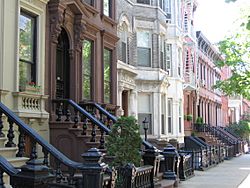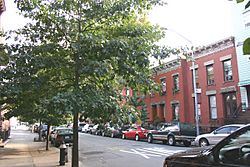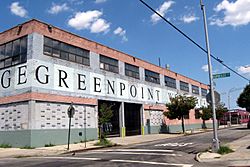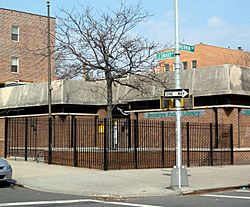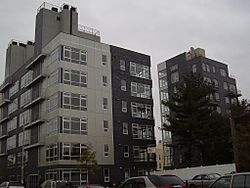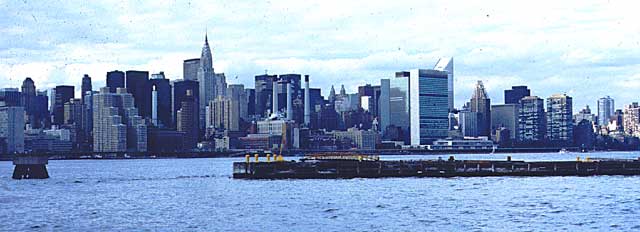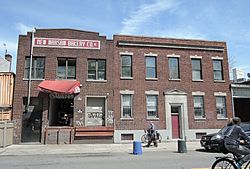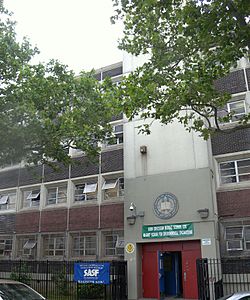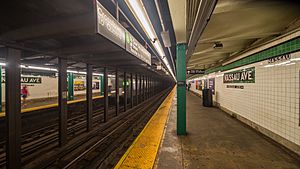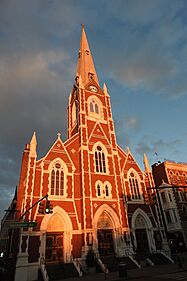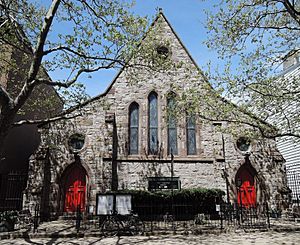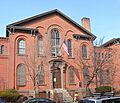Greenpoint, Brooklyn facts for kids
Quick facts for kids
Greenpoint
|
|
|---|---|
|
Neighborhood
|
|
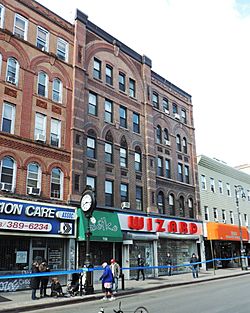
Greenpoint streetscape on Manhattan Avenue (2014)
|
|
| Country | |
| State | |
| City | New York City |
| Borough | Brooklyn |
| Community District | Brooklyn 1 |
| Languages | |
| Area | |
| • Total | 1.26 sq mi (3.3 km2) |
| Population
(2010)
|
|
| • Total | 34,719 |
| • Density | 27,550/sq mi (10,640/km2) |
| Demographics 2010 | |
| • White | 76.9% |
| • Black | 1.2% |
| • Hispanic (of any race) | 14.7% |
| • Asian | 4.9% |
| • Other | 2.3% |
| ZIP Code |
11222
|
| Area code(s) | 718, 347, 929, and 917 |
| Median household income | ,523 |
Greenpoint is a lively neighborhood located in the northern part of Brooklyn, New York City. It shares borders with Williamsburg to the southwest and East Williamsburg to the southeast. To the north, it meets Newtown Creek and Long Island City in Queens. The East River forms its western edge.
Greenpoint is famous for its large Polish community. You can find many Polish restaurants, markets, and businesses here. Because of this, it's often called Little Poland.
Long ago, Greenpoint was mostly farmland. Over time, it grew into a busy area with factories and shipyards. It became known as a place for working-class families and immigrants. Many people found jobs in factories, shipbuilding, and dock work.
Since the early 2000s, Greenpoint has changed a lot. New buildings have gone up, and it has become a popular spot for nightlife. A plan in 2005 allowed for more homes to be built along the waterfront. There are also efforts to create more parks and walking paths along the East River and Newtown Creek.
Greenpoint is part of Brooklyn Community District 1. Its main ZIP Code is 11222. The New York City Police Department's 94th Precinct keeps the neighborhood safe.
Contents
Greenpoint's Past: A Look Back
How Greenpoint Began
When Europeans first arrived in New York, the Keskachauge (Keshaechqueren) Indians lived in Greenpoint. People described the area as very green and beautiful. It had forests, meadows, fresh water, and marshes. There were many birds and fish. The name "Greenpoint" first referred to a small piece of land by the East River. Later, it described the whole area.
In 1638, the Dutch West India Company made a deal with the Lenape people to settle Brooklyn. The first European settler in Greenpoint was Dirck Volckertsen from Norway. In 1645, he built a farmhouse near what is now Calyer Street and Franklin Street. He grew crops and raised animals. The Dutch called him Dirck de Noorman, meaning "Norseman." A creek near his farm was named Norman Kill (Creek).
Volckertsen sold and leased parts of his land to other Dutch settlers. One of them was Jan Meserole, who started a farm in 1663. His farmhouse stood until 1919. Later, Pieter Praa, a local militia captain, owned most of Greenpoint. By the time of the American Revolutionary War, only five related families lived in Greenpoint. These families were the Meseroles, Bennetts, Provoosts, and Calyers.
The British Army set up camp in Greenpoint during the American Revolution. This made life hard for the families living there. For a long time, the farms were quite isolated from the rest of Brooklyn. People used boats to travel to Manhattan to sell their produce.
Growing into an Industrial Hub
Greenpoint started to change a lot when Neziah Bliss bought land there in the 1830s. He had the area surveyed in 1834. In 1839, he opened a public road along what is now Franklin Street. He also started regular ferry service to Manhattan around 1850. These changes helped Greenpoint grow quickly. It became part of the City of Brooklyn in 1855.
Greenpoint became a major center for shipbuilding and trade by water. Its factories made ropes, printed materials, pottery, and glass. Many generations of immigrants worked in these industries. Germans and Irish arrived in the mid-19th century, followed by many Poles. The homes built for workers and merchants still stand today. This area is now known as the Greenpoint Historic District.
The neighborhood's waterfront has a rich maritime history. The USS Monitor, the Union's first ironclad warship, was built here during the American Civil War. It was launched on Bushwick Creek. In 1866, the largest wooden ship ever built, The Great Republic, was constructed along Newtown Creek.
Charles Pratt's Astral Oil Works opened in Greenpoint in the 1860s. Pratt later sold his share to John D. Rockefeller's Standard Oil company in 1874. The Astral Apartments were built in 1886 to house workers from Astral Oil.
The Union Porcelain Works factory was also in Greenpoint. It operated from 1862 to 1922. This company was famous for its new ways of making porcelain. Its products were highly respected in both America and Europe.
Greenpoint in Recent Times
The oil industry continued to grow, even with some accidents. In 1919, a Standard Oil refinery caught fire. The flames spread to nearby oil works and Newtown Creek.
After World War II, Greenpoint's manufacturing industry began to shrink. The Eberhard Faber Pencil Factory, once the biggest pencil maker in the U.S., closed in 1956. Its old buildings are now a historic district.
The Greenpoint Historic District was added to the National Register of Historic Places in 1983.
Environmental Efforts
Greenpoint residents have worked together to fight pollution in their neighborhood. In 1994, the city closed a large incinerator that was not following environmental rules. In the 1980s, a group called GASP (Greenpointers Against Smell Pollution) formed. They pushed the city to control bad smells from the Sewage Treatment Plant.
In 1950, a huge oil spill happened in Newtown Creek. Between 17 and 30 million gallons of oil leaked into the water. Oil has been seeping into the ground since then. Local activists have been working to clean up this spill. In 2006, officials said that about half of the spill had been cleaned up.
The EPA has studied the oil spill. They found that some commercial buildings had high levels of oil vapors. However, a recent report from the Department of Environmental Conservation found no evidence of oil or dangerous vapors in people's homes.
Changes in Zoning (2005)
In 2005, New York City approved a plan to change the zoning rules for 175 blocks in Greenpoint and Williamsburg. This plan was expected to bring about 16,700 new residents to the neighborhood by 2013. It also planned for new shops. However, it meant losing over 1 million square feet of industrial space. The plan also included a 28-acre waterfront park. Developers building along the waterfront were required to create a walking path.
The new zoning allowed for taller buildings along the waterfront. This was if developers included affordable apartments for lower-income families. This rezoning was a big change for the neighborhood, which used to have mostly low-rise industrial buildings. Some people, like urban planner Jane Jacobs, worried about these changes.
Others, including the city government, argued that building more homes was needed. They said it would help with the city's housing shortage. Critics worried that the neighborhood's character would change. They also feared that public transportation and safety services would not be able to handle the many new residents.
After the rezoning, a lot of construction began. This led to complaints from residents. The zoning plan was changed slightly in 2006. It added rules to protect tenants and set height limits in some areas.
Who Lives in Greenpoint?
Greenpoint has many working-class families. It's common to find three generations of a family living there. The neighborhood is often called "Little Poland" because of its large Polish community. It has the second largest Polish population in the United States after Chicago. Besides Polish residents, there are also many Latino, South Asian, and North African people.
In 2010, Greenpoint's population was 34,719. Most residents were White (76.9%) or Hispanic (14.7%). There were also smaller groups of African American and Asian residents.
Greenpoint and Williamsburg together had about 199,190 people in 2018. The average life expectancy was 81.1 years. Most residents are middle-aged adults and young people. In 2016, the average household income was $76,608. About 17% of residents lived in poverty in 2018.
Staying Safe in Greenpoint
The New York City Fire Department (FDNY) has two fire stations in Greenpoint. Engine Company 238/Ladder Company 106 is on Greenpoint Avenue. Engine Company 229/Ladder Company 146 is on Richardson Street.
Mail and Post Office
Greenpoint uses ZIP Code 11222. The United States Postal Service has a post office called Greenpoint Station at 66 Meserole Avenue.
Learning in Greenpoint
Greenpoint and Williamsburg have more college-educated residents than the rest of New York City. About half of the people have a college degree or higher. Students in Greenpoint and Williamsburg are getting better at reading and math.
The number of elementary school students missing many school days is a bit higher than the city average. However, 77% of high school students graduate on time, which is higher than the city average.
Schools in Greenpoint
Greenpoint has several public elementary schools for grades PK-5:
- PS 31 Samuel F Dupont
- PS 34 Oliver H Perry
- PS 110 The Monitor
The public middle school for grades 6–8 is:
- John Ericsson Middle School 126
The public high schools for grades 9–12 are:
- Automotive High School
- Frances Perkins Academy
Public Library
The Brooklyn Public Library (BPL)'s Greenpoint branch is at 107 Norman Avenue. It used to be a Carnegie library built in 1906. The library closed in 2017 for a two-year renovation. It will become a new building called the Greenpoint Library & Environmental Education Center.
Getting Around Greenpoint
Greenpoint has two subway stations: Greenpoint Avenue and Nassau Avenue. These are on the IND Crosstown Line (G train). Several New York City Bus routes also serve the area, including the B24, B32, B43, B48, B62.
Since 2011, NY Waterway (now NYC Ferry) has offered ferry service along the East River. Greenpoint has a ferry stop at India Street.
There are also plans for a new light rail system called the Brooklyn–Queens Connector (BQX). It would run along the waterfront from Red Hook to Astoria, passing through Greenpoint. This project is expected to be very expensive and may not open until 2029 or later.
Cool Places and Landmarks
Street Names
When Neziah Bliss planned Greenpoint, he named the east-west streets in alphabetical order. They were first called "A Street," "B Street," and so on. Later, they got longer names. Today, you'll find streets like Ash, Box, Clay, Dupont, Eagle, Freeman, Green, Huron, India, Java, Kent, Greenpoint (Avenue), Milton, Noble, Oak, Calyer, and Quay Streets. Greenpoint Avenue was once called Lincoln Street. Calyer Street was named after a local family.
Parks to Explore
- McCarren Park is the biggest park in Greenpoint. It used to be called Greenpoint Park.
- McGolrick Park is smaller. It has a historic Shelter Pavilion (built in 1910). It also has a monument to the ironclad ship USS Monitor (from 1938).
- WNYC Transmitter Park opened in 2012 on the East River. It used to be a radio transmission site.
- "Right Angle Park" is a small playground. It's located where Commercial, Dupont, and Franklin Streets meet. The park is shaped like a right triangle.
Historic Buildings and Sights
The Greenpoint Historic District includes many old buildings. It's roughly located between Kent, Calyer, Noble, and Franklin Streets.
Some interesting buildings in Greenpoint are:
- The Episcopal Church of the Ascension (1853) on Kent Street. It's the oldest church in Greenpoint.
- The Astral Apartments (1885) on Franklin Street.
- The Saint Anthony of Padua Roman Catholic Church (1875) on Manhattan Avenue.
- The Eberhard Faber Pencil Factory on Greenpoint Avenue at Franklin Street.
- The Russian Orthodox Cathedral of the Transfiguration of Our Lord (1921) on North 12th Street.
- PS 34, the Oliver H. Perry School (1867) on Norman Avenue. This is the oldest public school building in New York City that is still used.
- The Capital One (formerly Green Point) Savings Bank (1908).
- The Saint Stanislaus Kostka Roman Catholic Church (1896) on Humboldt Street. This is a Catholic shrine for the Polish community.
- The synagogue building of Congregation Ahavas Israel (1903) on Noble Street. It has beautiful stained glass windows.
A commercial building called Keramos Hall on Manhattan Avenue was restored. It won an award in 2013 for its beautiful features. The Kickstarter headquarters is in Greenpoint. It's located in the old Eberhart Faber Pencil Factory on Kent Street. This building was also renovated and won awards.
St. Cecilia's Roman Catholic Church and School have served the community since 1871. The current church building dates back to 1891.
Famous People from Greenpoint
Many notable people have lived in or were born in Greenpoint, including:
- Awkwafina (born 1988), a rapper and actress.
- Pat Benatar (born 1953), a pop singer.
- Margaret Wise Brown (1910–1952), a children's book author who wrote Goodnight Moon.
- Charles Evans Hughes (1862–1948), who became the 11th Chief Justice of the United States.
- Mickey Rooney (1920–2014), a famous actor.
- Mae West (1893–1980), an actress.
Images for kids


